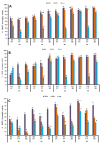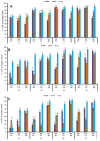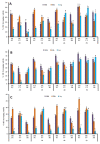Comparative Study on Phytochemical Profile and Antioxidant Activity of an Epiphyte, Viscum album L. (White Berry Mistletoe), Derived from Different Host Trees
- PMID: 34208051
- PMCID: PMC8230609
- DOI: 10.3390/plants10061191
Comparative Study on Phytochemical Profile and Antioxidant Activity of an Epiphyte, Viscum album L. (White Berry Mistletoe), Derived from Different Host Trees
Abstract
The study aimed at evaluating the antioxidant profile of a medicinal epiphyte Viscum album L. harvested from three tree species, namely, Populus ciliata L, Ulmus villosa L., and Juglans regia L. The crude extracts were obtained with ethanol, methanol, and water and were evaluated for the total phenol content (TPC), total flavonoid content (TFC), and antioxidant activities using total reducing power (TRP), ferric reducing antioxidant power (FRAP), 1, 1-diphenyl 1-2-picryl-hydrazyl (DPPH), superoxide radical scavenging (SOR), and hydroxyl radical scavenging (•OH) assays. Our results showed that crude leaf extracts of plants harvested from the host Juglans regia L. exhibited higher yields of phytochemical constituents and noticeable antioxidative properties. The ethanolic leaf samples reported the highest phenols (13.46 ± 0.87 mg/g), flavonoids (2.38 ± 0.04 mg/g), FRAP (500.63 ± 12.58 μM Fe II/g DW), and DPPH (87.26% ± 0.30 mg/mL). Moreover, the highest values for TRP (4.24 ± 0.26 μg/mL), SOR (89.79% ± 0.73 mg/mL), and OH (67.16% ± 1.15 mg/mL) were obtained from aqueous leaf extracts. Further, Pearson correlation was used for quantifying the relationship between TPC, TFC, and antioxidant (FRAP, DPPH, SOR, OH) activities in Viscum album L. compared to their hosts. It was revealed that the epiphyte showed variation with the type of host plant and extracting solvent.
Keywords: antioxidant; epiphyte phytochemical; extraction; plant extract.
Conflict of interest statement
The authors declare no conflict of interest.
Figures







Similar articles
-
Phytochemical Screening, Antioxidant and Antifungal Activities of Aconitum chasmanthum Stapf ex Holmes Wild Rhizome Extracts.Antioxidants (Basel). 2022 May 26;11(6):1052. doi: 10.3390/antiox11061052. Antioxidants (Basel). 2022. PMID: 35739952 Free PMC article.
-
Phytochemical Profile and Antioxidant Capacity of Viscum album L. Subsp. album and Effects on Its Host Trees.Plants (Basel). 2022 Nov 9;11(22):3021. doi: 10.3390/plants11223021. Plants (Basel). 2022. PMID: 36432750 Free PMC article.
-
Effects of age and extraction solvent on phytochemical content and antioxidant activity of fresh Moringa oleifera L. leaves.Food Sci Nutr. 2018 Sep 14;6(8):2188-2198. doi: 10.1002/fsn3.783. eCollection 2018 Nov. Food Sci Nutr. 2018. PMID: 30510720 Free PMC article.
-
Phytochemical profile and therapeutic potential of Viscum album L.Nat Prod Res. 2016;30(4):373-85. doi: 10.1080/14786419.2015.1022776. Epub 2015 Mar 27. Nat Prod Res. 2016. PMID: 25813519 Review.
-
Utilization of the Viscum Species for Diet and Medicinal Purposes in Ruminants: A Review.Animals (Basel). 2022 Sep 26;12(19):2569. doi: 10.3390/ani12192569. Animals (Basel). 2022. PMID: 36230309 Free PMC article. Review.
Cited by
-
Traditional Uses, Phytochemical Constituents and Ethnopharmacological Properties of Mistletoe from Phoradendron and Viscum Species.Comb Chem High Throughput Screen. 2024;27(8):1093-1110. doi: 10.2174/1386207326666230825113631. Comb Chem High Throughput Screen. 2024. PMID: 37622692 Review.
-
A Scoping Review of Genus Viscum: Biological and Chemical Aspects of Alcoholic Extracts.Plants (Basel). 2023 Apr 28;12(9):1811. doi: 10.3390/plants12091811. Plants (Basel). 2023. PMID: 37176869 Free PMC article.
-
In silico profiling of analgesic and antihyperglycemic effects of ethanolic leaves extract of Amischotolype mollissima: Evidence from in vivo studies.Saudi J Biol Sci. 2022 Jul;29(7):103312. doi: 10.1016/j.sjbs.2022.103312. Epub 2022 May 20. Saudi J Biol Sci. 2022. PMID: 35663844 Free PMC article.
-
Curative potential of Populus ciliata Wall ex. Royle extract against adjuvant-induced arthritis and peripheral neuropathy in Wistar rats.Inflammopharmacology. 2023 Dec;31(6):3081-3100. doi: 10.1007/s10787-023-01248-3. Epub 2023 Jun 2. Inflammopharmacology. 2023. PMID: 37266813
-
Exploring the Antioxidant Potential of Blackberry and Raspberry Leaves: Phytochemical Analysis, Scavenging Activity, and In Vitro Polyphenol Bioaccessibility.Antioxidants (Basel). 2023 Dec 16;12(12):2125. doi: 10.3390/antiox12122125. Antioxidants (Basel). 2023. PMID: 38136244 Free PMC article.
References
-
- Gengatharan A., Dykes G.A., Choo W.S. Betalains: Natural plant pigments with potential application in functional foods. LWT Food Sci. Technol. 2015;64:645–649. doi: 10.1016/j.lwt.2015.06.052. - DOI
LinkOut - more resources
Full Text Sources
Miscellaneous

